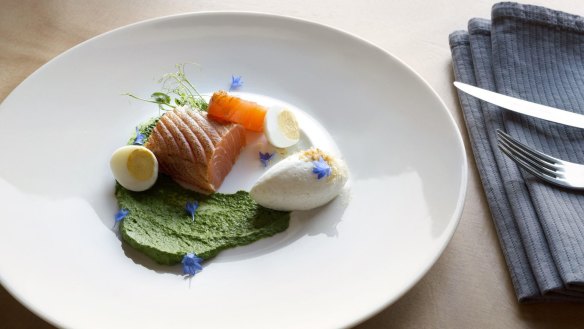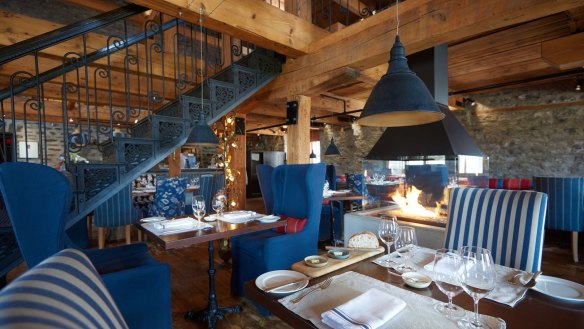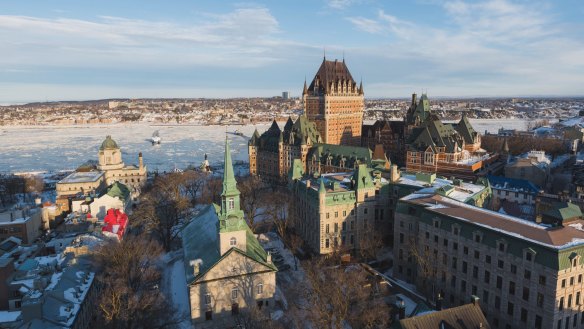Where to eat and drink in Quebec City, Canada

You could almost be in Brittany. Down at the harbour, Bistro St-Malo on the rue St-Paul has rough stone walls plastered in old Gauloises posters. Businesspeople sit elbow-to-elbow over duck leg, cassoulet and rabbit in red wine. Soon, you might be tucking into mussels, soaking up the juices with hunks of baguette. Chatter swirls like the snowflakes beyond the windows, though the French sounds slurred, as if spoken through mouthfuls of hearty soup.
The accent is the only clue this isn't France. Quebec City is beautiful, but curious too. You get North American history through a French prism, and wonder what might have been had General Wolfe not won a decisive battle here for British domination of the continent in 1759. The Quebecois are survivors of France's American empire. They erect flamboyant fountains sporting bare-breasted nymphs and fly the royalist fleur-de-lys as if the French Revolution never happened. Naturellement, they tuck into French food and wine. Restaurants such as the impeccable Le Saint-Amour have a thousand French wine labels in its 12,000-bottle cellar.
Like the best of travel, Quebec makes you pause and see the world from a different perspective. Basse-Ville (Lower Town) on the waterfront is where it all began. Rue du Petit-Champlain claims to be North America's oldest street. Nearby are 1691 French fortifications. Old streets have a special charm in winter, when they twinkle with fairy lights. If you're after souvenir maple syrup and fudge, look no further. Pass further along the river, though, and Basse-Ville begins to feel more like backstreet Paris.

This area, Vieux-Port, is where ships from Europe once docked to service the fledgling colony, and is now a star location for dining. You'll find several classic French eateries here such as the very polished L'Echaude, with its bent wooden chairs, stiff white tablecloths and traditional offerings such as beef tartare, duck confit and rabbit leg – though snappily plated in contemporary style. Laurie Raphael provides an 11-course menu of considerable chic that runs from charcoal-grilled scallop with strawberry and basil to crab-and-leek pasta with white asparagus and caviar.
At Chez Muffy you get a skilful farm-to-fork dining experience that focuses on Quebec ingredients and slow cooking techniques in a rustic maritime setting. It's the perfect comfort food for winter, when snow sits on city's rooftops and ice creaks on the St Lawrence River. A final temptation is the more formal Restaurant Initiale, where you can snuggle up amid cherry-wood panelling, open fires and leather, and tuck into lamb leg and Atlantic halibut. Both restaurants are branded Relais & Chateaux, whose member properties are always noted for offering sophisticated food.
Work off your excesses by clambering up the staircase to Haute-Ville (Upper Town) on the clifftop above. You emerge on lovely Dufferin Terrace, which overlooks Basse-Ville's rooftops and the river, and is presided over by an enormous statue of Samuel de Champlain, the 17th-century French navigator who founded Quebec City on July 3, 1608. He's sometimes called the "Father of New France" because he made the first accurate maps of Canada's east coast, and helped establish its trading settlements. It's easy to overlook the importance of early French endeavours in North America, but not in Quebec City, where the town is dotted with names such as Cartier, Champlain and Montfort.

Quebec's most prominent landmark, though, is neither French nor British but splendidly and improbably Canadian. Chateau Frontenac is one of a chain of vast railway hotels built across Canada in the 19th century to assert the glories of the wilderness and the confidence of the new country. Under snow, this ogre-sized castle looks particularly storybook. One of the region's most celebrated chefs Stephane Modat is at the helm of its Restaurant Champlain, serving ambitious nouvelle cuisine quebequoise that includes caribou in sweet-and-sour maple syrup, and partridge with red cabbage in rosehip vinegar. The cheese room is a delight to behold.
Haute-Ville is stuffed with history and an abundance of historic houses, churches – including the oldest Anglican cathedral outside the British Isles – and pretty squares. Maison Kent may well be the city's oldest building (1648) and is notable for being the place where the French surrendered to the British, changing the history of North America. Nearby Maison Jacquet dates from 1675 and houses restaurant Aux Anciens Canadiens where rustic but scrumptious dishes include smoked bison, meat pies and French-Canadian classic poutine (fries covered in curds and gravy) served by wenches in period costume.
Don't miss the Hotel du Parlement (parliament building) just outside the old city walls, whose fountain and facade are the epitome of French design – unlike in other Canadian cities, whose provincial parliaments favour London-inspired neo-Gothic architecture. The outside of the building is lined by 22 bronzes showing prominent figures from Quebec history. You can do a tour, though you'd be better off heading to the rather wonderful Beaux-Arts Restaurant Le Parlementaire. State dinners are hosted here, but at lunchtimes you can tuck into fine regional fare such as smoked trout with fennel-and-rhubarb salad, or sheep's cheese in puff pastry.
Follow the Grand-Allee to find a street lined by bars and restaurants that make this something of an evening hotspot, spilling outside in summer and cosily tucked away inside in winter. You can also get a terrific walk if you skirt up the hillside behind. It will lead you past the Citadelle, an early 19th-century fort built by the British, and still a Canadian army garrison. Keep going and you join a path that leads along the St Lawrence River. Jack Frost might be nibbling at your toes, but you can shake off your latest meal and ponder the vagaries of history as you admire snow-covered views.
Details
Aux Anciens Canadiens, auxancienscanadiens.qc.ca
Bistro St-Malo, lecafesaintmalo.com
Chez Muffy, saint-antoine.com/chez-muffy
Laurie Raphael, laurieraphael.com
L'Echaude, echaude.com
Le Saint-Amour, saint-amour.com
Restaurant Champlain, restaurantchamplain.com
Restaurant Initiale, restaurantinitiale.com
Restaurant Le Parlementaire, assnat.qc.ca/leparlementaire
Restaurant reviews, news and the hottest openings served to your inbox.
Sign up